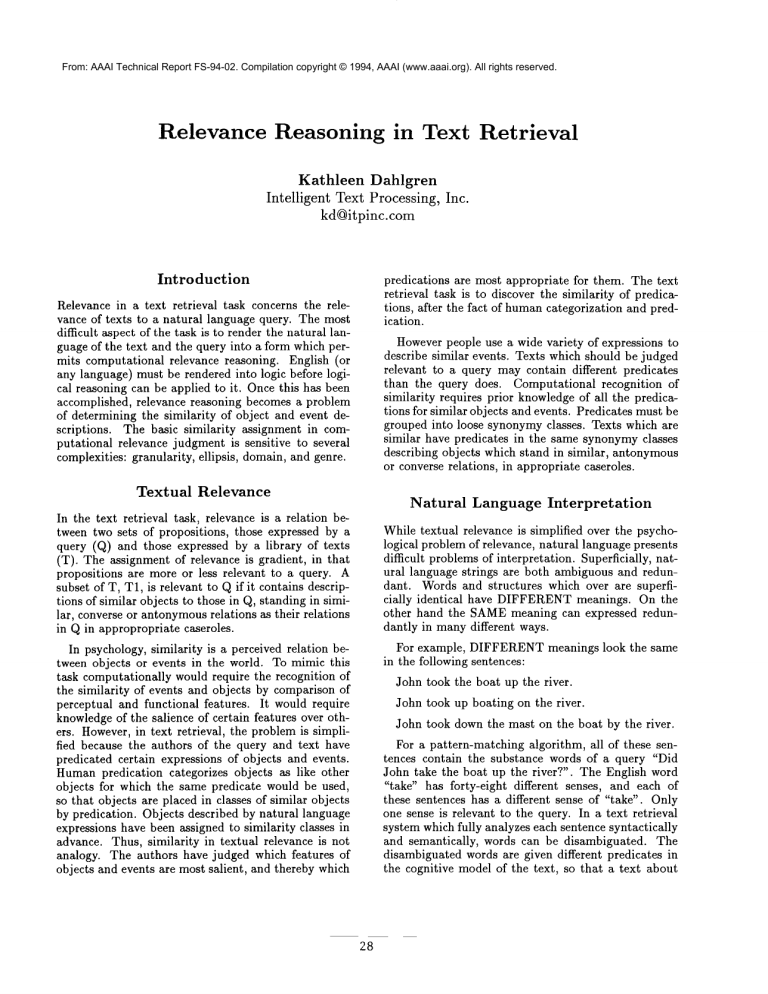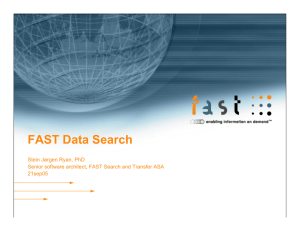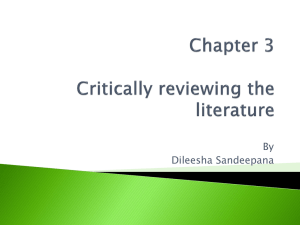
From: AAAI Technical Report FS-94-02. Compilation copyright © 1994, AAAI (www.aaai.org). All rights reserved.
Relevance
Reasoning
in Text Retrieval
Kathleen Dahlgren
Intelligent Text Processing, Inc.
kdQitpinc.com
Introduction
predications are most appropriate for them. The text
retrieval task is to discover the similarity of predications, after the fact of humancategorization and predication.
Relevance in a text retrieval task concerns the relevance of texts to a natural language query. The most
difficult aspect of the task is to render the natural language of the text and the query into a form which permits computational relevance reasoning. English (or
any language) must be rendered into logic before logical reasoning can be applied to it. Oncethis has been
accomplished, relevance reasoning becomes a problem
of determining the similarity of object and event descriptions. The basic similarity assignment in computational relevance judgment is sensitive to several
complexities: granularity, ellipsis, domain, and genre.
Howeverpeople use a wide variety of expressions to
describe similar events. Texts which should be judged
relevant to a query may contain different predicates
than the query does. Computational recognition of
similarity requires prior knowledgeof all the predications for similar objects and events. Predicates must be
grouped into loose synonymyclasses. Texts which are
similar have predicates in the same synonymyclasses
describing objects which stand in similar, antonymous
or converse relations, in appropriate caseroles.
Textual Relevance
Natural
In the text retrieval task, relevance is a relation between two sets of propositions, those expressed by a
query (Q) and those expressed by a library of texts
(T). The assignment of relevance is gradient, in that
propositions are more or less relevant to a query. A
subset of T, T1, is relevant to Q if it contains descriptions of similar objects to those in Q, standing in similar, converse or antonymousrelations as their relations
in Q in appropropriate caseroles.
Language Interpretation
While textual relevance is simplified over the psychological problem of relevance, natural language presents
difficult problemsof interpretation. Superficially, natural language strings are both ambiguous and redundant. Words and structures which over are superficially identical have DIFFERENTmeanings. On the
other hand the SAMEmeaning can expressed redundantly in manydifferent ways.
For example, DIFFERENTmeanings look the same
in the following sentences:
In psychology, similarity is a perceived relation between objects or events in the world. To mimic this
task computationally would require the recognition of
the similarity of events and objects by comparison of
perceptual and functional features. It would require
knowledgeof the salience of certain features over others. However,in text retrieval, the problem is simplified because the authors of the query and text have
predicated certain expressions of objects and events.
Humanpredication categorizes objects as like other
objects for which the same predicate would be used,
so that objects are placed in classes of similar objects
by predication. Objects described by natural language
expressions have been assigned to similarity classes in
advance. Thus, similarity in textual relevance is not
analogy. The authors have judged which features of
objects and events are most salient, and thereby which
John took the boat up the river.
John took up boating on the river.
John took down the mast on the boat by the river.
For a pattern-matching algorithm, all of these sentences contain the substance words of a query "Did
John take the boat up the river?". The English word
"take" has forty-eight different senses, and each of
these sentences has a different sense of "take". Only
one sense is relevant to the query. In a text retrieval
system which fully analyzes each sentence syntactically
and semantically, words can be disambiguated. The
disambiguated words are given different predicates in
the cognitive model of the text, so that a text about
28
physically taking will only be relevant to those cognitive models with the physical reading of "take" or
similar predicates..
On the other hand, the SAMEmeaning has the potential of being expressed in hundreds of different ways,
as in the following:
1) John steered the boat up the river.
2) John’s boat trip was up the river.
3) John cruised up the river.
4) The boat travelled up the river. John was captain.
5) John was captain of a boat. He took it up the
river.
The first two text is a basic active sentence in which
there is a verb (steer), subject (John) and object
boat) and prepositional phrase (up the river). It is relatively straightforward to assign relevance for text (1)
and a query "Did John take the boat up the river?"
by recognizing the similarity of the predicates "take"
and "steer". The second text expresses the same event
with a nominal "trip". To find that text (2) is relevant
to the query "Did John take the boat up the river?",
the relevance mechanismmust find the subject and object cases of the nominal, and then reason that subject
and object case roles are similar to subject and object
cases of the query verb. The verb in third text has a
single word "cruise" to describe the event of "taking a
boat" in the query. The relevance mechanismmust see
the similarity of single with multiple predicates. The
fourth text has identifies John with an agentive role
"captain". To recognize that John is captain in the
"travel" event of the prior sentence, the two sentences
have to be related by coherence reasoning. The fifth
text has pronouns which must be resolved in order to
find that John took the boat.
Intelligent Text Processing’s full natural language
approach to text retrieval has modules which imitate every level of human linguistic reasoning. The
propositions of the text and query are produced when
a natural language understanding system, Interpretext, translates English into logic. It parses the
text [E. P. Stabler, 1992], disambiguates words and
structures [Dahlgren, McDowell, & Stabler, 1989],
forms a discourse representation structure [Wada &
Asher, 1986], finds antecedents of anaphoric expressions [Wada, 1994], and assigns coherence relations
between events [Dahlgren, 1989]. The translation of
"John took the boat up the river" is, in part, as follows.
take3(el,nl,thel).
boatl(tl,thel).
anchor (n 1 john).
direction(el,the2).
river(the2).
before(el ,now).
Interpretext retrieves and uses world knowledge in
the form of naive semantic representations for the content words in the text [Dahlgren, 1988]. The lexical
representations are naive theories of the properties of
objects and the implications of events, and are available during relevance reasoning. Megabytes of text in
seven domains have been interpreted by this system.
Text retrieval in one domain has been implemented
and exceeds 95%precision and recall using the methods described in this paper [Dahlgren, 1992].
Since Interpretext translates text into a cognitive
model consisting of logic expressions, with all words
disambiguated and all anaphoric expressions resolved,
extremely precise textual relevance reasoning is possible. In contrast with pattern-matching techniques,
this form of representation prevents false hits for cases
where the target text has many of the same strings as
the query, used in different senses. For example, for
our query "Did John take the boat up the river?", Interpretext with full disambiguation does NOTretrieve
the text "John took up boating on the river", because
a different meaning of "take" is used in the query and
target text. This full form of representation is not
fooled when argument structures differ. The query,
"Did John take Mary?" it will not retrieve texts about
Mary taking John. Because anaphors are resolved, it
can find a text with a pronoun or other anaphoric expression in place of a query word, as in text (5) above.
Relevance
of Objects
Relevance judgementdiffers for objects, events and situations. Object similarity in textual relevance can be
determined with simple predicate matching and loose
synonymy, or by more complex reasoning with background knowledge. Simple predicate matching relies
upon word sense disambiguation. In the following
texts, "train" has two different senses. Only T1, where
"train" has a vehicle sense, is relevant to the query Q.
T1. John took a train up the river.
T2. John traveled with his followers in train.
Q. Did John travel by train?
The cognitive model of T1 is, in part,
take3(el,nl,al).
trainl(al).
direction(el,thel).
river(thel).
The cognitive model of Q is, in part,
29
travel 1 (e2,n2).
means(e2,a2).
trainl(a2).
In the similarity computation, take3 and travell
are found to be similar event predications, trainl and
trainl found to be similar object predications, and the
caserole "means"is found to fulfill the samerole as the
object role of take3.
However,the cognitive model of T2 is, in part,
travell(e2,n2).
accompaniment(e2,cl).
follower(cl).
location(cl,the3).
train5(the3).
the trip" and "Mary took John on the trip". It also
knows that "John took Mary on the trip" is similar to
"Mary was taken on the trip by John", and "Mary went
on John’s trip". Events with similar consequences are
similar ("travel", "drive", "come"). Converse events
are similar as long as arguments are in the appropriate caseroles ("leave" and "return", "receive" and
"give"). Sometimesthe function of an object makes it
relevant to an event ("book" to "read", "tractor" to
"ploughing", "knife" to "cutting"). Antonymsare relevant ("win" and "lose"). If an event is queried, and
its negation has been reported in a text, the text is
typically relevant.
Both verbs and nominals are predicated of events.
T with "trip up the river" is relevant to Q with "travel
up the river". The recovery of caseroles in nominals is
important for accurate retrieval. For example, text (6)
is relevant to query (8), but not text (7).
In the similarity computation, travell and travell
are found to be similar events predications, but trainl
and train5 are found to be dissimilar object predications, and relevance fails.
(6) John’s trip up the river was fun.
Object names or their synonyms may not be present
in a relevant text. Anobject with similar functions can
be relevant ("hoe" is relevant to "trowel", "scalpel"
to "knife")¯ An instrumental object can stand for an
activity or role ("hoe" for "gardening", "scalpel" for
"surgery" or "surgeon". Metonymicrelations can drive
relevance assignment ("mainsail" for "boat", "tractor"
for "farm" or "farming"). A textual object which falls
into the class of objects named by a query predicate
is relevant (Q has "boat" and T has "trawler"; Q has
"river" and T has "Amazon"). The naive semantic lexical representations in Interpretext contain these synonyms, functions, instruments, part and ontological relations, so that relevance reasoning requires no new
types of lexical information, though relevance reasoning drives lexical enhancement.
Beyond simple predicate similarity,
more complex
relations must be found. An expression with several predicates has the same meaning as (denotes the
same kinds of objects as) a single predicate, so that
paraphrase relations must be recognized (e.g., "fishing
boat" and "trawler"). On the other hand, parts of expressions are redundant or empty and must be ignored
("factor" in "risk factor", "have" in "boat which has
jib").
Relevance of Events
Relevant textual events are those which involve similarly described objects in similarly described relations
in appropriate caseroles. Similarity of events, as with
objects, can be assigned through loose synonymy of
predicates ("travel" and "journey") or through reasoning with world knowledge. Given a full text interpretation with argument structure, the relevance reasoner
rejects texts with the same objects in converse relations
¯ It knows the difference between "John took Mary on
3O
(7) The trip up the river for John was fun.
(8) Whowent up the river?
This can be discovered by inspection of caseroles of
the nominal "trip". The cognitive model of (6), has the
following predicates, in part, showing John as subject
of the trip.
tripl(el).
subject(el,nl).
anchor(nl john).
direction(el,the2).
river(the2).
fun(el).
In contrast, the cognitive model of (7) has a benefactive caserole for John, and no subject for the trip.
So it is irrelevant query (8).
tripl(e2).
benefactive(e2,nl).
anchor(nljohn).
direction(e2,the2).
river(the2).
fun(e2).
Relevance of Situations
The relevance reasoning mechanisms presented in this
paper are inadequate for queries which describe complex situations with manypredicates. They are sufficient to produce retrievals as long as queries are relatively short (under ten verbs). For longer queries,
mechanism to compute the salience of events in the
query should be added. Otherwise, no relevant texts
can be found, because the probability of finding any
text describing all of the objects in all of the relations
of the situation described by the long query approaches
zero.
Complexities
of Textual
Reasoning
Relevance
that the query and text have similar granularity, or
the query is narrower, the relevance reasoning can be
more successful. To the text extent that the text is
explicitly structured, the text interpreter can more accurately recover antecedents and topics, and the relevance reasoning can thereby be more precise and have
better recall.
One of the complexities in relevance reasoning is ontological granularity of the query, individual texts, and
the library. Queries which are too broad must be recognized and intercepted. A query about "Latin America" to a library sufficiently large to have an unmanageable number of retrievals about Latin America is
too broad. A query needs to be at about the granularity of some text topic, segment topic or sentence, and
not broader. As overly narrow queries fail, no screening against them is needed. In general, if Q is coarser
than T, and the predicates of T are below Q in the
ontology, it is relevant. If Q is finer-grained than T,
and propositions similar to Q are in T, T is relevant.
References
Dahlgren, K.; McDowell, J. P.; and Stabler, E. P.,
J. 1989. Knowledge representation for commonsense
reasoning with text. Computational Linguistics.
Dahlgren, K. 1988. Naive Semantics for Natural Language Understanding. Boston, MA: Kluwer.
Dahlgren, K. 1989. Coherence relation
In Proc. Cognitive Science Society.
Another complexity is anaphora and ellipsis.
The
natural language interpreter must recover antecedents
of linguistic devices such as pronouns and definite descriptions. Otherwise recall is lowered by failure to
assign relevance to elements which stand for relevant
predicates. In (5), "he" stands for John, and "it" stand
for the boat, so that (5) is relevant to the Q "Did John
take the boat up the river?". In order to compute the
relevance of (5), these pronouns must be resolved.
assignment.
Dahlgren, K. 1992. Interpretation of textual queries
using a cognitive model. In Lauer, T.; Peacock, E.;
and Graesser, A., eds., Questions and Information
Systems. Hillsdale, N J: Erlbaum.
E. P. Stabler, J. 1992. The Logical Approach to Syntax: Foundations, Specifications,
and Implementations of Theories of Government and Binding. Cambridge, MA:MIT Press.
Furthermore, assuming the implicit relevance of topics predicates can enhance recall. In a text entitled
"John’s cruise up the river", John, the boat and the
river are implicitly present and relevant throughout the
text. Similarly, events in a segment of text are potentially relevant to all events in the same segment, but
not to events in other segments.
Wada, H., and Asher, N. 1986. BUILDRS:An implementation of DR theory and LFG. In Proc. COLING,
540-545.
Wada, H. 1994. A treatment of functional
descriptions. In Proc. COLING.
A third complexity is domain, or field of activity. Texts in a certain domains prefer particular word
senses. For example, in financial texts the financial
senses of "bank" and "asset" are preferred, while in
geography texts, other senses are preferred.
A final complexity is genre. In highly structured
texts, especially those with explicitly formulated requirements, the automatic extraction of topics and
segments is not necessary because the authors are required to segment the text and provide titles of sections. Using segments, the search for relevant events
can be speeded up. Reasoning to less structured texts
is slower because it cannot be focused in segments. Location of antecedents of anaphors is less precise in less
structured texts, as well, resulting in false hits.
Conclusion
In conclusion, precise textual relevance reasoning requires disambiguated words, recovery of argument
structure, assignment of case roles, interpretation of
nominals and reference to world knowledge. Relevance
reasoning is enhanced by treatment of ellipsis,
and
recognition of the domain of a text. To the extent
31
definite




